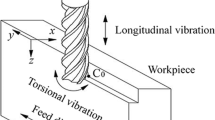Abstract
Renewal of the manufacturing process for thread is important in a variety of products and industry applications. Especially for machining the internal trapezoidal thread, the cutting edge is in a semi-closed state, three cutting edges and two cutting tips are in contact with the workpiece, resulting the heat is not easy to spread out. At the same time, the narrow space of the internal thread leads to the poor rigidity of the tool, the instability of the machining state, which seriously affects the surface machining quality of the parts. Here, a new precision processing device of axial ultrasonic-assisted turning (AUAT) is designed, which can achieve the industrial application of machining internal thread parts. The device can work stably at a working frequency of about 28.8 kHz. Secondly, considering that the bottom and flank of the thread need to be machined at the same time, the contact mode of the tool is different between them. The main cutting edge of the tool contacts the workpiece intermittently on the flank tooth, forming the texture surface which is conducive to the transmission of the thread pair. On the bottom teeth, the main cutting edge is always in contact with the workpiece and carries out the axial sawing movement. The high-frequency axial vibration damping effect is obvious, which suppresses the unstable machining state such as chatter and improves the machining surface quality of the bottom teeth. Finally, Ti–6Al–4V trapezoid thread is selected in the verification, in which the separation effect of ultrasonic vibration cutting is verified, the cutting force is tested, and the machined surface topography of the workpiece is analyzed. Experimental results show that the quality of thread was significantly improved in AUAT.














Similar content being viewed by others
References
Muhammad R, Ahmed N, Demiral M, Roy A, Silberschmidt VV (2011) Computational study of ultrasonically-assisted turning of Ti alloys. Adv Mater 223:30–36
Muhammad R, Hussain MS, Maurotto A, Siemers C, Roy A, Silberschmidt VV (2014) Analysis of a free machining α + β titanium alloy using conventional and ultrasonically assisted turning. J Mater Process Technol 214(4):906–915
Hafiz MSA, Kawaz MHA, Mohamad WNF, Kasim MS, Izamshah R, Saedon JB, Mohamed SB (2017) A review on feasibility study of ultrasonic assisted machining on aircraft component manufacturing. IOP Conf Ser Mater Sci Eng 270:012034
Wang JJ, Feng PF, Zhang JF, Guo P (2018) Experimental study on vibration stability in rotary ultrasonic machining of ceramic matrix composites: cutting force variation at hole entrance. Ceram Int 44(12):14386–14392
Patil S, Joshi S, Tewari A, Joshi SS (2014) Modelling and simulation of effect of ultrasonic vibrations on machining of Ti6Al4V. Ultrasonics 54:694–705
Koshimizu S (2008) Ultrasonic vibration-assisted cutting of titanium alloy. Key Eng Mater 389–390:277–282
Cakir FH, Gurgen S, Sofuoglu MA, Celik ON, Kushan MC (2015) Finite element modeling of ultrasonic assisted turning of Ti6Al4V alloy. Proc Soc Behav Sci 195:2839–2848
Ma C, Wang Z (2018) Experimental and numerical investigation of the breakage of a cutting tool with ultrasonic vibration. Precis Eng 51:393–402
Lotfi M, Amini S, Aghaei M (2018) 3D analysis of surface topography in vibratory turning. Int J Adv Manuf Technol 95(1–4):197–204
Geng DX, Zhang DY, Li Z, Liu DP (2017) Feasibility study of ultrasonic elliptical vibration-assisted reaming of carbon fiber reinforced plastics/titanium alloy stacks. Ultrasonics 75:80–90
Kuo KL (2007) Experimental investigation of ultrasonic vibration-assisted tapping. J Mater Process Technol 192–193:306–311
Bai W, Sun RL, Leopold J (2016) Numerical modelling of microstructure evolution in Ti6Al4V alloy by ultrasonic assisted cutting. Proc CIRP 46:428–431
Bai W, Sun RL, Leopold J, Silberschmidt VV (2017) Microstructural evolution of Ti6Al4V in ultrasonically assisted cutting: numerical modelling and experimental analysis. Ultrasonics 78:70–82
Bai W, Bisht A, Roy A, Suwas S, Sun RL, Silberschmidt VV (2018) Improvements of machinability of aerospace-grade Inconel alloys with ultrasonically assisted hybrid machining. Int J Adv Manuf Technol 101(5–8):1143–1156
Khanna N, Suri NM, Agrawal C, Shah P, Krolczyk GM (2019) Effect of hybrid machining techniques on machining performance of in-house developed Mg-PMMC. Trans Indian Inst Met 72(7):1799–1807
Zhang C, Guo P, Ehmann KF, Li YG (2016) Effects of ultrasonic vibrations in micro-groove turning. Ultrasonics 67:30–40
Yang Y, Pan YY, Guo P (2017) Structural coloration of metallic surfaces with micro/nano-structures induced by elliptical vibration texturing. Appl Surf Sci 402:400–409
Zhang C, Shi GL, Ehmann KF (2017) Investigation on hybrid micro-texture fabrication in elliptical vibration-assisted cutting. Int J Mach Tool Manuf 120:72–84
Zhang JJ, Wang DZ (2018) Investigations of tangential ultrasonic vibration turning of Ti6Al4V using finite element method. Int J Mater Form 12(5–8):1–11
Sofuoğlu MA, Çakır FH, Gürgen S, Orak S, Kuşhan MC (2018) Numerical investigation of hot ultrasonic assisted turning of aviation alloys. J Braz Soc Mech Sci 40(3):122
Yan LT, Zhang QJ, Yu JZ (2018) Effects of continuous minimum quantity lubrication with ultrasonic vibration in turning of titanium alloy. Int J Adv Manuf Tech 98(1–4):827–837
Sofuoğlu MA, Çakır FH, Gürgen S, Orak S, Kuşhan MC (2018) Experimental investigation of machining characteristics and chatter stability for Hastelloy-X with ultrasonic and hot turning. Int J Adv Manuf Technol 95(1–4):83–97
Gürgen S, Çakır FH, Sofuoğlu MA, Orak S, Kuşhan MC (2019) Multi-criteria decision-making analysis of different non-traditional machining operations of Ti6Al4V. Soft Comput 23:5259–5272
Acknowledgements
Foundation item: Project was supported by (KYLX16_0321) Jiangsu Province Ordinary University Graduate Student Scientific Research Innovation Projects.
Author information
Authors and Affiliations
Corresponding author
Additional information
Technical Editor: Adriano Fagali de Souza.
Publisher's Note
Springer Nature remains neutral with regard to jurisdictional claims in published maps and institutional affiliations.
Rights and permissions
About this article
Cite this article
Hou, Y., Zuo, D., Wang, L. et al. Experimental evaluation for internal trapezoidal thread with axial ultrasonic vibration cutting of Ti–6Al–4V. J Braz. Soc. Mech. Sci. Eng. 42, 247 (2020). https://doi.org/10.1007/s40430-020-02301-w
Received:
Accepted:
Published:
DOI: https://doi.org/10.1007/s40430-020-02301-w




